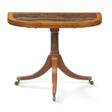Regency in France
.jpg)
Regency in France
The Regency era in France, spanning from 1715 to 1723, marked a significant period in French history and culture. This era began when King Louis XV was a minor, and the country was governed by Philippe d'Orléans as the prince regent. Known for its transition in decorative arts, the Regency style was a precursor to the Rococo style and played a key role in shaping the cultural and artistic landscape of 18th-century France.
This era was characterized by a shift from the massive, rectilinear forms of King Louis XIV's style to those prefiguring the Rococo style of Louis XV. The Regency style in furniture and art was significant for its incorporation of structural and ornamental elements inspired by Greek and Roman antiquity.
Artists like Antoine Watteau and Jean-Baptiste Pater were pivotal during this period. Watteau's works, often enigmatic and poignant, captured the mood of the era, while Pater continued Watteau's legacy after his death, embracing the Rococo tastes and refining figures in graceful groups with cool, powdery colors.
For collectors and experts in art and antiques, the Regency era in France offers a fascinating glimpse into a time of transition and innovation in art and culture. This era's contributions are crucial in understanding the evolution of European art, leading to the flourishing of Rococo and the onset of the Enlightenment.
If you are fascinated by the art and culture of the Regency era in France, sign up for updates. We provide exclusive access to new discoveries, sales, and auction events related to this significant period in art history. Join us to delve deeper into the legacy of the Regency era.
| Country: | Europe, France |
|---|---|
| Start of the period: | 1715 |
| End of the period: | 1723 |

